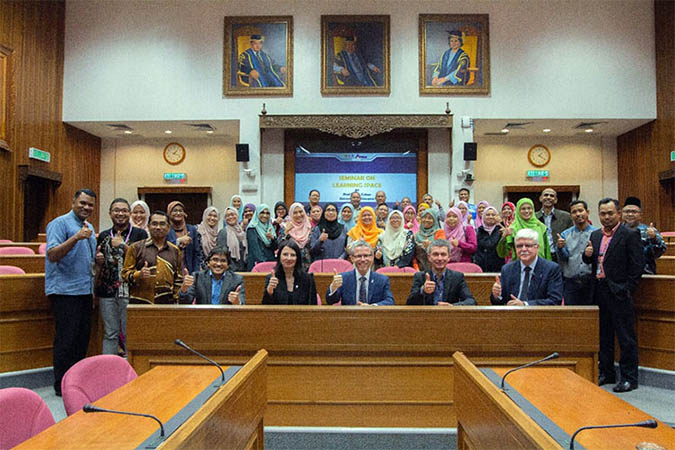IMPORTANCE OF LEARNING SPACES - VIEWS SHARED BY UNIVERSITY OF GLASGOW ACADEMICS

PENANG, 13 Sept. 2018 – Teaching and learning activities have always been an important part of a university. Together with research and consultancy, universities at present have a wider role to play in relation to the dissemination of knowledge and expertise.
The availability of sufficient space for effective learning is just as important as the people and technology involved in the process. In realising its importance, the Academic and International Division, Universiti Sains Malaysia (USM) recently held a seminar on Learning Space, presented by academics from the University of Glasgow (GU), Scotland.
The programme started with the opening remarks delivered by the Director, Centre for Development of Academic Excellence and Student Development (CDAE) at USM, Professor Dr. Abdul Karim Alias.
Following that, Professor Frank Coton, the Vice-Principal of Academic & Educational Innovation, as head of the group presented on the topic of Learning Space.
He began by giving an overview of the achievements of GU, being the 4th oldest university in the UK, and where it currently stands in the academic world.
“Glasgow is the biggest city in Scotland and was named one of the happiest places to live in,” he said with much pride.
However, he added, there is much to learn from USM and Penang, with the warm welcome accorded to him during his past visits here.
He then proceeded to talk about how important it is to have a more conducive space for teaching and learning for the students and staff, which would lead to better outcomes.
“GU has embarked on creating more conducive learning spaces to better support teaching and learning activities as they move to develop independent, skilled and highly-valued graduates.
“Workplace setting would differ from classrooms, and students would need to be able to work in different environments,” he said.
He also said that GU hopes to develop learning spaces that would not create any ‘divide’ between the teacher and the students, while being flexible in arrangement, promote active and collaborative learning, providing space for students to study in a quiet or socialised setting, being adjacent to other facilities, and with sufficient connectivity and energy supply.
“Student leaders were also brought in, together with multi-disciplinary team members in planning and finalising the designs required for the learning spaces. This is to ensure that GU students would benefit from the total campus experience and interaction,” Frank explained.
“Factors that were considered in creating the learning spaces were the layout, choice of furniture, technology to be incorporated, acoustics of the rooms, lighting and colour choices.
“Effects on the students that were taken into account were the level of comfort, the appeal of the spaces, how conducive are the rooms for studying and learning, natural lighting sources, provision of quiet/social zones and efficient connectivity and energy sources,” he explained further.
Frank mentioned in ending the talk that, the aim of establishing such learning spaces was to support enhanced learning opportunities for students, efficient usage and planning of space designs, providing a harmonious setting for different types of teaching and learning methods, and to support the development of basic and practical skills for the students.
Other members of the group from GU present were Professor Bill Cushley,Dean for Global Engagement (S&SE Asia), (Office of the Vice-Principals); Dr Clare McManus, Senior Management (College of Social Sciences) and Dr Anselm Heinrich (Senior Lecturer, School of Culture and Creative Arts).
The talk was held at the University Conference Hall and those in the audience of approximately 80 included the Heads of Departments and key officials of the university.
Text: Mazlan Hanafi Basharudin
- Created on .
- Hits: 1567
